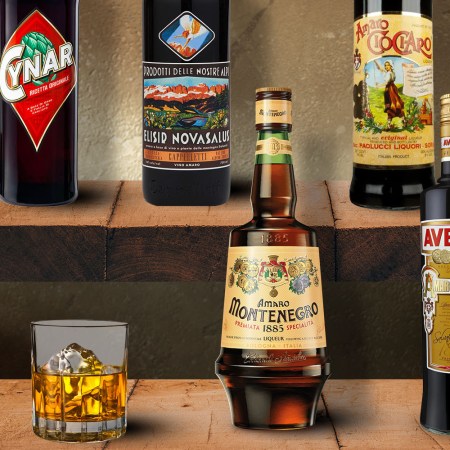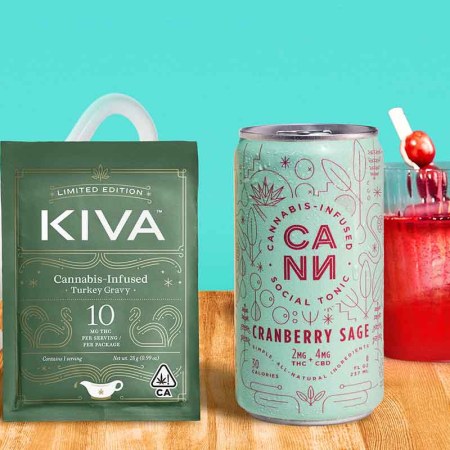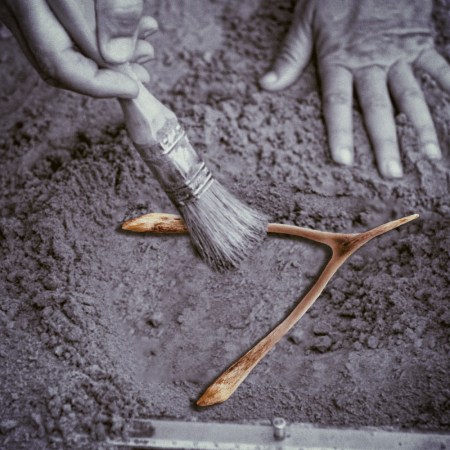It’s one of the most familiar parts of Thanksgiving, right up there with football and giant inflatables being marched through Herald Square. But while the food coma is an inevitable aspect of the holiday, how you deal with it is entirely up to you.
Before you surrender to the urge to nap, consider incorporating an amaro into your after-dinner tradition. The Italian digestif — a bittersweet herbal liqueur available in countless varieties — is proven to aid digestion after a heavy meal.
“In Italy, amaro is not just a holiday drink but it’s an everyday after-meal drink,” says Pietro Caldarelli, beverage director at Feroce Ristorante inside the Moxy Chelsea NYC, which offers over 50 amaros and grappas. “So we definitely use lots of amaro, especially when we have corso, very abundant dinners or lunch. It’s something that we enjoy a lot. And the start of amaro goes back to a tradition in the pharmacy and the monks. The monks would make amaro. It really helps you a lot when you eat so much and you need to digest.”
But beyond helping your stomach cope with that third helping of green bean casserole, offering your Thanksgiving guests amaro after dinner is an excuse to linger while introducing loved ones to something they may not be as familiar with as say, cognac or a dessert wine. And as John Filkins, the beverage director at Officina in Washington, D.C. — which also boasts a library of rare amaros — notes, there’s an amaro for everyone.
“There are a variety of different styles of amaro out there, kind of depending on what you like in terms of bitterness versus sweetness scale,” he says. “So I think that’s the great thing, you can make it as approachable as you want and it can be kind of this great introductory thing to help the digestion process for a holiday where everyone kind of has to unbutton the belt after Thanksgiving a little bit and hang out with family and friends and kind of enjoy themselves.”
Related: The Life and Times of a Fernet-Branca Scion
If you prefer something on the sweeter side, Filkins recommends Montenegro, an amaro he describes as “slightly softer and nuttier, a little more on the caramelized side.” Caldarelli lists amaros like Averna, Fernet-Branca and Amaro del Capo as the classic examples of the style. But if you enjoy bitters and are feeling more adventurous, Filkins says “pretty much anything that says Fernet on it is going to be on that bitter side,” but he recommends an alpine-style amaro for this time of year.
“As you move into the winter and those warmer months, I tend to recommend a lot of what’s called an alpine-style amaro, which tends to be a little more on the bitter side — not quite as bitter as something, say, Fernet-Branca,” he explains. “But it kind of has that warming effect. A lot of those traditional alpine spices, things that you might smell when you’re skiing or kind of in those colder months of the year that I would associate with Thanksgiving. A little more of a heavy on the spices, things along those lines.”
For family members looking to step outside their comfort zones at the Thanksgiving table, Caldarelli recommends his personal favorite amaro, Braulio.
“Braulio is from Lombardi, from Valtellina,” he says. “It’s one of the most elegant amari that you can find. It’s very well-known. It’s a long tradition that goes back… Every time you drink Braulio you really go retreat to the Alps, to Valtellina. It’s very aromatic. You smell the pines. It’s beautiful.”
Amaro is traditionally drunk neat, but both Filkins and Caldarelli note that it goes well in cocktails as well — and incorporating it into a cocktail may be a good way for beginners to ease into drinking it.
“Right now we feature a lot of amaros and hot drinks,” Filkins says. “Honestly, even something like hot chocolate or coffee. We do a hot chocolate drink with Braulio with a little bit of bourbon and hot chocolate and then whipped cream on top with a little bit of Fernet-Branca, gives us kind of minty aloe ferox tone to it, which is delicious. Or kind of in the traditional Italian way, you can do coffee with a shot of amaro. Sometimes we’ll mix it with an affogato, so gelato, amaro and coffee, which is a great way to kind of introduce people to maybe some of those more bitter amaros that they generally may not like because it’s getting balanced by a little more of that sweetness of the gelato. And then you get something like coffee, which kind of is traditionally at the end of a meal anyway. So it’s a nice introduction.”
Filkins estimates that there are about 15 or 20 different amaro brands that you can easily find in any liquor store. But if you’re looking for something on the rare side, try poking around at your neighborhood garage sale.
“We’ve definitely had some guests who’ve come in and said, ‘Hey, I found this really great amaro. Can you tell me anything about it? I bought it at an estate sale,’” he says. “And then a lot of these amaros, we’ve found and bought from auction or different producers. They’re not made anymore and there’s really no history on them. So that’s kind of the fun exploration of it; a lot of these things some of our guests come in and taste, we’ve never tasted ourselves. It adds a little bit of the experience to it. Or I’ve had wine makers who’d come in and say, ‘Oh, I recognize that amaro, he used to sell grapes to my grandfather,’ or something like that…Finding that information as we go is kind of the fun part of the journey.”
Exploring the rich history of amaro is definitely something Caldarelli encourages Americans to do.
“They need to know the amaro is part of the history of Italy,” he explains. “And is a very long tradition. Every time you point, there are thousands of amari. Literally, thousands. Every time you drink an amari you drink the history of the place. There are lots of botanicals, lot of stories, lots of families behind. So definitely it’s very fascinating, the history of every single amaro. It’s very fascinating. Amaro Lucano, the same family. Averna is the same family. We can keep going, but for me, it’s fantastic that the recipes are still known to everybody.”
But while it’s important to recognize the origins of the tradition, you don’t have to be Italian to enjoy the practice of nursing one last drink while you settle your stomach as the holiday comes to a close.
“It’s very much a part of Italian culture and I think it adds to the overall experience,” Filkins says. “When you think of Thanksgiving, you think of wine and beer and food and family and pumpkin pie and all of these things, and everybody always talks about pairings. ‘This is what you should drink for Thanksgiving,’ this and that. But no one ever really talks about what you should enjoy with dessert and then kind of to get over that Thanksgiving hangover, Thanksgiving cure, whatever you want to call it. I think amaro would be a great place at that table.”
This article was featured in the InsideHook newsletter. Sign up now.


















